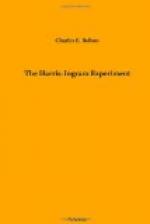While the huge steel plant at Harrisville was being constructed, a large force of men were building a conduit to protect copper tubes, from the steel plant to the coal fields. At the mines hundreds of miners were set at work, several shafts were sunk, and tunnels, levels, and winzes were developed.
George Ingram believed that all the force in the world available for man’s use was derived from the sun; so he heroically resolved to hitch his wagon, if not to a star, to the mighty sun. With this purpose in view, he had bought the 20,000 acres of coal land. Half of this area was located in Jefferson, Harrison, and Belmont counties on the Ohio River, and thus title was secured to vast quantities of fossil power in the upper coal measures, which ignites quickly and burns with a hot fire. The other 10,000 acres were valuable because nearer to Harrisville. This coal came from lower measures or seams.
George Ingram had made a thorough study of coal, or fossil fuel, its formation and value. The coal of the carboniferous age is derived almost entirely from the family of plants called Lycopods, or club mosses, and the ferns, which back in high antiquity attained gigantic size. The microscope has clearly developed this vegetable origin of coal. The great Appalachian and other coal fields are without doubt, the long continued and vigorous forest growths, and subsequent fossilization of the same in the marginal swamps of ancient gulfs or seas.
The agency of transfer for solar energy is the vegetable kingdom. The vegetable cell has the surprising property through the sun’s agency of being able to live and multiply itself on air alone. The carbon of carbonic acid, a constituent of the atmosphere, is so liberated and appropriated, as to become fixed in the forming tissues of plants. Thus the plant is a storer of light and heat, a reservoir of force. It mediates between the sun’s energy and the animal life of the world. Thus coal seams are the accumulations of the sun’s energy for thousands of centuries, requiring the patient growth and slow decay of hundreds of immense forests. One secret of the unprecedented late growth of cities is discovered in the steam engine, or the coal which feeds it.
A pound of good coal, used in a good engine, stands for the work of six horses for an hour; a ton of coal for the work of thirteen hundred horses for a day of ten hours; ten thousand tons of coal, used in a day by single lines of railways, stand for the work of thirteen million horses, working ten hours a day. In 1894 the English mines produced 188,277,525 tons of coal. In Great Britain alone, coal does the work of more than a hundred millions of men, and adds proportionately to the fabulously increasing wealth of those fortunate islands.
The Ingrams had solved two important problems, and on their practicable application depended the success of the great Harris-Ingram experiment. The more important of the two was the unlocking of the sun’s stored energy, electricity, at the coal mines. The second was a device for conveying this energy from the mines to the steel plant, and it had been patented to protect it.




